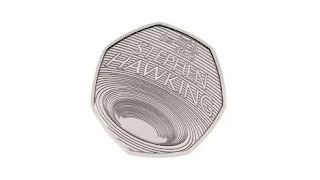The United Kingdom’s Royal Mint will honor the work of Stephen Hawking with a commemorative coin featuring the physicist’s name above concentric circles representing a black hole. It looks pretty awesome.
The famous scientist died last year and is perhaps most known in the scientific community for his study of black holes and the idea that black holes can evaporate via “Hawking radiation.” Non-scientists know him through his works of popular science writing, including A Brief History of Time, his various appearances in pop culture, and his ability to thrive despite the paralyzing effects of his motor neurone disease.
Edwina Ellis designed the coin, reports the BBC. Not only is it pretty amazing that a conceptual drawing of a black hole appears on a coin, but I’ll bet it’s the most advanced physics equation to ever appear on currency.
That equation describes the entropy of a black hole—entropy can be understood as the number of different microscopic configurations that could add up to the macroscopic qualities you observe, or how a system’s energy disperses out at a given temperature. It’s interesting to ask the entropy of a black hole, because we know that not even light can escape a black hole; but at the same time, the laws of physics say that the entropy of a system can’t spontaneously decrease. So in the early 1970s, physicists like Hawking began to ask what happened to the total entropy of the system when things fell into black holes.
Hawking’s work led to the idea of Hawking radiation, the theory that black holes must radiate matter from their surfaces, also known as their event horizons. The idea represents an important milestone in physics, and the equation is an important combination of the laws of gravity, called general relativity, with the laws of the smallest particles, called quantum mechanics.
Uncirculated copies of the coin are available for purchase at the Royal Mint’s website.

No comments:
Post a Comment